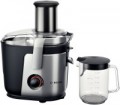Juice container
The volume of the built-in or freestanding juice tank (see Juice capacity). It is usually in the range from 0.2 to 2 liters. Doing more volumes, usually, does not make sense — freshly squeezed juice is considered the most useful, and it quickly loses its properties. Therefore, the best option is to prepare small portions of juice
up to 1 liter, with the expectation that you can drink it right away. On the other hand, for the preparation of canned juices,
a tank volume of 1.5 – 2 liters is usually quite enough.
Pulp container
The volume of the tank for the oil cake (pressed pulp) installed in the juicer.
While most models with a pulp tank come equipped with an automatic pulp ejection function (see "Functions"), there are some exceptions. Nevertheless, the size of the tank directly affects the duration for which the juicer can be used without having to empty the oil cake residue. However, an increase in capacity significantly impacts the device's dimensions, weight, and cost.
Modern juicers are designed with oil cake containers ranging from 200-500 mL in the most compact models to 3 liters or more in larger ones. The specific capacity is usually chosen by designers based on the unit's total power and performance. However, models with similar performance characteristics may differ in their oil cake container volume. When selecting a juicer, it's important to consider the intended use of the device. For occasional home use, a smaller container may suffice, but for a cafe or bar where freshly squeezed juices are prepared regularly, a larger capacity juicer may be the better option.
Power
The power of the juicer depends on its type. For example, the power of citrus juicers rarely exceeds 40 W, since the structure of citrus fruits is easily destroyed and does not require serious effort to extract juice.
The power of centrifugal juicers can even exceed 1000 W. The centrifugal speed and spin features depend on the power of the centrifugal juicer (for more details, see Number of speeds)
Loading opening width
The width of the opening for loading products into the centrifugal juicer. You should pay attention to this parameter if you plan to get juice from large fruits such as apples or pears — if the opening is less than 70 mm wide, the fruits will most likely have to be cut into pieces.
Body material
The body of a modern juicer is most often made of plastic or steel.
Plastic juicers tend to weigh less and cost less; in turn,
metal ones are more durable and look “more respectably”. The body material usually does not affect the functionality of the device.
Compartment for cord
A special compartment in the body of the device for storing the power cord. Often such compartments are also equipped with devices for uniform winding of the wire, which prevents bending and possible fractures.
The cord compartment is especially useful if the juicer is used relatively rarely and is left idle for a long time outside the kitchen.

